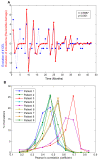Modeling the effector - regulatory T cell cross-regulation reveals the intrinsic character of relapses in Multiple Sclerosis
- PMID: 21762505
- PMCID: PMC3155504
- DOI: 10.1186/1752-0509-5-114
Modeling the effector - regulatory T cell cross-regulation reveals the intrinsic character of relapses in Multiple Sclerosis
Abstract
Background: The relapsing-remitting dynamics is a hallmark of autoimmune diseases such as Multiple Sclerosis (MS). Although current understanding of both cellular and molecular mechanisms involved in the pathogenesis of autoimmune diseases is significant, how their activity generates this prototypical dynamics is not understood yet. In order to gain insight about the mechanisms that drive these relapsing-remitting dynamics, we developed a computational model using such biological knowledge. We hypothesized that the relapsing dynamics in autoimmunity can arise through the failure in the mechanisms controlling cross-regulation between regulatory and effector T cells with the interplay of stochastic events (e.g. failure in central tolerance, activation by pathogens) that are able to trigger the immune system.
Results: The model represents five concepts: central tolerance (T-cell generation by the thymus), T-cell activation, T-cell memory, cross-regulation (negative feedback) between regulatory and effector T-cells and tissue damage. We enriched the model with reversible and irreversible tissue damage, which aims to provide a comprehensible link between autoimmune activity and clinical relapses and active lesions in the magnetic resonances studies in patients with Multiple Sclerosis. Our analysis shows that the weakness in this negative feedback between effector and regulatory T-cells, allows the immune system to generate the characteristic relapsing-remitting dynamics of autoimmune diseases, without the need of additional environmental triggers. The simulations show that the timing at which relapses appear is highly unpredictable. We also introduced targeted perturbations into the model that mimicked immunotherapies that modulate effector and regulatory populations. The effects of such therapies happened to be highly dependent on the timing and/or dose, and on the underlying dynamic of the immune system.
Conclusion: The relapsing dynamic in MS derives from the emergent properties of the immune system operating in a pathological state, a fact that has implications for predicting disease course and developing new therapies for MS.
Figures






References
-
- Vollmer T. The natural history of relapses in multiple sclerosis. J Neurol Sci. 2007;256(Suppl 1):S5–13. - PubMed
-
- Stone LA, Frank JA, Albert PS, Bash C, Smith ME, Maloni H, McFarland HF. The effect of interferon-beta on blood-brain barrier disruptions demonstrated by contrast-enhanced magnetic resonance imaging in relapsing-remitting multiple sclerosis. Ann Neurol. 1995;37(5):611–619. doi: 10.1002/ana.410370511. - DOI - PubMed
-
- Boiko A, Vorobeychik G, Paty D, Devonshire V, Sadovnick D. Early onset multiple sclerosis: a longitudinal study. Neurology. 2002;59(7):1006–1010. - PubMed
Publication types
MeSH terms
Grants and funding
LinkOut - more resources
Full Text Sources

